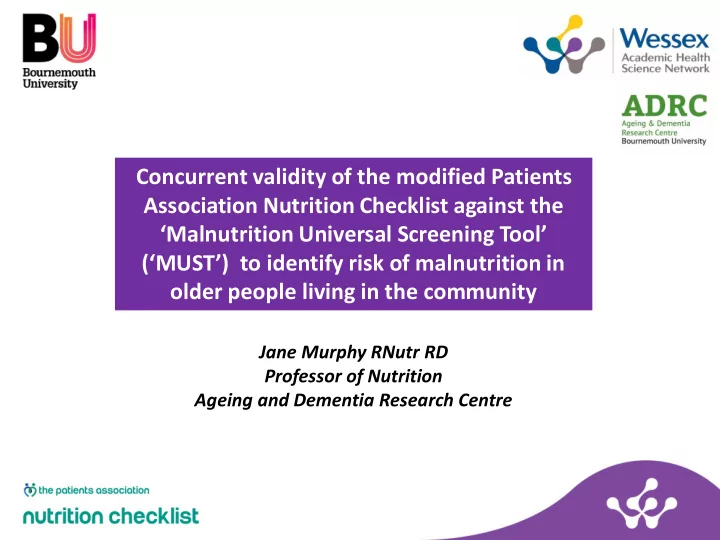

Concurrent validity of the modified Patients Association Nutrition Checklist against the ‘Malnutrition Universal Screening Tool’ (‘MUST’) to identify risk of malnutrition in older people living in the community Jane Murphy RNutr RD Professor of Nutrition Ageing and Dementia Research Centre
The Research Team Prof Jane Annemarie Alethea Kathy Wallis Dr Emma Parsons Murphy Aburrow Guestini (Associate (Research Fellow), ADRC , (Dietitian), (Researcher), Director), NIHR Biomedical Bournemouth Wessex AHSN Bournemouth Wessex AHSN Research Centre, University & University University of Wessex AHSN Southampton
Rationale – the problem of malnutrition in the community • The majority of people with or at risk of malnutrition are living in the community: 1 in 10 older people (MTF, 2017) • Malnutrition still remains under-detected and under-treated (Wilson, 2011), despite NICE guidance and quality standards recommending nutritional screening using validated tools such as ‘MUST’ • Malnutrition results from disease-related, physical and social factors – social risk factors are an important consideration in the community • Growing population of older people with increasing complex health needs • Need for new validated approaches in the community to help identify risk of malnutrition, provide signposting & advice, that can be used by the wider workforce and volunteers
What is the Patients Association Nutrition Checklist? • A simple tool designed to identify potential malnutrition risk • Involves asking an older person 4 key questions to focus discussions around weight loss and nutrition, to identify potential risk of malnutrition (Section A) • For those likely to be an increased risk, guidance on the provision of basic advice and signposting is provided (Section B) • Initial testing has been carried out in domiciliary care, Hampshire Fire & Rescue Service, Age UK Southampton
The Patients Association Nutrition Checklist questions
Aim A cross-sectional study to investigate the concurrent validity of the Patients Association Nutrition Checklist to identify the risk of malnutrition in older people living in the community against ‘MUST’
Methods Local organisations offering lunch, social and activity clubs across Hampshire and Dorset were attended by a dietitian and researcher between January and May 2018 All participants were aged 65 and over and were recruited on the day and gave informed written consent Participants were asked the questions from the Patients Association Nutrition Checklist and were then screened using ‘MUST’ (Elia,2003) Agreement and chance-corrected agreement (ĸ) between ‘MUST’ and the Patients Association Nutrition Checklist were assessed (Landis & Koch, 1977)
Results: Participants • 312 older people were recruited from 21 lunch and activity clubs across Dorset (n=140) and Hampshire (n=172) • Mean age was 79.6 years (SD 8.3) • Mean BMI was 27.8 kg/m 2 (SD 5.6) • 197 older people (63%) were living alone
Results: Risk of malnutrition according to ‘MUST’ % at risk % at medium % at high risk risk 9.9% (n=31) 6.7% (n=21) 3.2% (n=10) Number of Breakdown of risk people Score 1 Score 2 Step 1 (BMI) 13 (42%) n=9 (69%) n=4 (31%) Step 2 (weight loss) 22 (71%) n=15 (68%) n=7 (32%) Step 3 (acute disease score) n=0 n=0
Results: Risk of malnutrition according to the Patients Association Nutrition Checklist No. participants answering ‘yes’ or ‘don’t know’ to each question (denoting risk) Q1 “are you or your family concerned you may be n=23 (34%) underweight or need nutritional advice?” Q2 “Have you lost a lot of weight unintentionally in n=30 (44%) the past 3- 6 months?” Q4 “Have you noticed that your clothes or rings n=37 (54%) have become loose recently?” Q4 “Have you recently found that you have lost n=38 (56%) your appetite and/or interest in eating?” Total ‘at risk’ 21.8% (n=68)
Results: Agreement between the tools • Moderate level of agreement between the two tools (sensitivity 85.4%, specificity 87.1%; ĸ= 0.47 (SE = 0.064), 95% CI [0.349, 0.599], P < 0.001) • There were 4 people at risk according to ‘MUST’ but not identified by the Patients Association Nutrition Checklist – these participants reported no change in weight and that they had always been slim • The Patients Association Nutrition Checklist identified more people at risk than ‘MUST’ – as it included people in the earlier stages of weight loss and with appetite changes
Conclusion The Patients Association Nutrition Checklist has: ✓ Acceptable sensitivity and specificity when compared with ‘MUST’ ✓ Potential for early identification of malnutrition risk and includes signposting to basic dietary advice and appropriate health and social care support
Next Steps • To understand how the Patients Association Nutrition Checklist could be effectively used by other stakeholders (volunteers, community workers and home care staff) to help reduce growing health and social care costs, and improve quality of life for older people • Opportunity to address and overcome some of the barriers to nutritional screening in the community • Review the ‘Managing Adult Malnutrition in the Community ’ pathway (with the checklist acting as a way to identify ‘clinical concern’ leading to ‘MUST’ screening)
Thank you for listening Any Questions?
Recommend
More recommend